供应链管理双语英文判断与选择翻译
- 格式:docx
- 大小:196.87 KB
- 文档页数:92

供应链管理英语Supply Chain Management is an integral part of modern business practices, ensuring efficiency and successful handling of goods and services from suppliers to customers. To communicate effectively in the industry, it is necessary to have a solid understanding of the language used in supply chain management. This article aims to provide a step-by-step guide on the importance of Supply Chain Management English, essential terminologies, and examples of its usage.Step 1: Importance of Supply Chain Management English The supply chain involves various parties, including manufacturers, suppliers, retailers, and customers. Effective communication amongst these parties is critical to ensurethat the flow of goods and services is smooth and efficient. English is the standard language used in international trade, making it necessary for individuals involved in the supply chain to have a good command of the language. The use of supply chain management English ensures clear and effective communication, avoiding misunderstandings and errors that could hinder the smooth flow of goods and services.Step 2: Essential TerminologiesTo communicate effectively in Supply Chain Management, it is necessary to understand essential terminologies such as:1) Procurement - the process of purchasing goods and services required by a business.2) Inventory Management - the process of ensuring that the right amount of goods is available in stock to meet customer demand.3) Logistics - the management of the flow of goods and services from the supplier to the customer.4) Warehousing - the process of storing goods beforethey are distributed to customers.5) Distribution - the process of delivering goods to customers.6) Freight - the payment for the transportation of goods.Step 3: Examples of UsageTo further understand the use of Supply Chain Management English, here are some examples of how it is used:1) “We need to optimize our supply chain to reduce lead time and increase efficiency.”2) “Our inventory management sys tem helps us keep track of stock levels to ensure that we never run out of supplies.”3) “Logistics is critical for our business as we needto ensure that our products are delivered to customers promptly.”4) “We have a well-organized warehousing system that ensures that our products are stored safely before distribution.”5) “Our freight rates have increased, and we need tofind ways to reduce costs without compromising quality.”ConclusionEffective supply chain management is essential for thesuccess of modern businesses. Being proficient in SupplyChain Management English ensures clear communication amongst parties, reducing mistakes and optimizing efficiency. Understanding essential terminologies and examples of its usage is critical for mastering Supply Chain Management English.。


Perspectives in supply chain risk managementChristopher S. TangUCLA Anderson School, 110 Westwood Plaza, UCLA, Los Angeles, CA 90095,USAReceived 3 November 2005; accepted 16 December 2005Available online 2 March 2006AbstractTo gain cost advantage and market share, many firms implemented various initiatives such as outsourced manufacturing and product variety. These initiatives are effective in a stable environment, but they could make a supply chain more vulnerable to various types of disruptions caused by uncertain economic cycles, consumer demands, and natural and manmade disasters. In this paper, we review various quantitative models for managing supply chain risks. We also relate various supply chain risk management (SCRM) strategies examined in the research literature with actual practices. The intent of this paper is three-fold. First, we develop a unified framework for classifying SCRM articles. Second, we hope this review can serve as a practical guide for some researchers to navigate through the sea of research articles in this important area. Third, by highlighting the gap between theory and practice, we hope to motivate researchers to develop new models for mitigating supply chain disruptions.Keywords:Supply chain risk management; Quantitative models; Review1. IntroductionOver the last 10 years, earthquakes, economic crises,SARS, strikes, terrorist attacks have disrupted supply chain operations repeatedly. Supply chain disruptions can have significant impact on a firm’s short-term performance. For example, Ericsson lost 400 million Euros after their supplier’s semiconductor plant caught on fire in 2000, andApple lost many customer orders during a supply shortage of DRAM chips after an earthquake hit Taiwan in 1999. Supply chain disruptions can have long-term negative effects on a firm’s financial performance as well. For instance, Hendricks and Singhal (2005) report that companies suffering from supply chain disruptions experienced 33–40% lower stock returns relative to their industry benchmarks.To mitigate supply chain disruptions associated with various types of risks (uncertain economic cycles,uncertain consumer demands, and unpredictable natural andman-made disasters), many researchers have developed different strategies/models for managing supply chain risks. In this paper, we review primarily quantitative models that deal with supply chain risks. Also, we relate various supply chain risk management (SCRM) strategies examined in the literature with actual practices. The intent of this paper is threefold. First, we develop a unified framework for classifying SCRM articles. Second, we hope this review can serve as a practical guide for some researchers to navigate through the sea of research articles in this important area. Third, by highlighting the gap between theory and practice, we hope to motivate researchers to develop new models for mitigating supply chain disruptions.2. Supply managementTo gain cost advantage, many firms outsourced certain non-core functions so as to maintain a focus on their core competence (cf., Porter (1985)). Since the 1980s, we witnessed a sea change in which firms outsourced their supply chain operations including design, production, logistics, information services, etc. Essentially, supply management deal with five inter-related issues:1. supply network design,2. supplier relationship,3. supplier selection process (criteria and supplierselection),4. supplier order allocation,5. supply contract.3.Demand managementIn Section 2, we describe how manufacturers can use different supply management strategies to mitigate various supply chain operational risks However, these supply management strategies are ineffective when the underlying supply mechanism is inflexible. For instance, in the service industry or in the fashion goods manufacturing industry, the supply mechanism is inflexible because the capacity is usually fixed. When the supply capacity is fixed, many firms have attempted to use different demand management strategies so that they can manipulate uncertain demands dynamically so that the modified demand is better matched with the fixed supply.Due to space limitation, we are unable to review the dynamic pricing or clearance pricing literature. The reader is referred to Elmaghraby and Keskinocak (2003) for an extensive review of dynamic pricing models and clearance pricing models for selling a fixed number of units over a finite horizon. Also, we do not plan to review literature that deal with coordination of pricing and ordering decisions. The reader is referred to Yano and Gilbert (2004),Petruzzi and Dada (1999), Eliashberg and Steinberg (1993) for three comprehensive reviews in this area. Instead, we shall focus on articles that emphasize on the use of demand management strategies to‘‘shape’’ uncertain demand so that a firm can use an inflexible supply to meet the modified demand.4. Product managementTo compete for market share, many manufacturers expand their product lines. As reported in Quelch and Kenny (1984), the number of stock keeping units (SKUs) in consumer packaged goods has been increasing at a rate of 16% every year between 1985 and 1992. Marketing research shows that product variety is an effective strategy to increase increasing market share because it enables a firm to serve heterogeneous market segments and to satisfy consumer’s variety seeking behavior. However, while product variety may help a firm to increase market share and revenue, product variety can increase manufacturing cost due to an increasein manufacturing complexity. Moreover, product variety can increase inventory cost due to an increase in demand uncertainty. These twoconcerns have been illustrated in an empirical study conducted by MacDuffie et al. (1996). They show that the production and inventory costs tend to increase as product variety increases. Therefore, it is critical for a firm to determine an optimal product portfolio that maximizes the firm’s profit. The reader is referred to Ramdas (2003) for a comprehensive review of literature in the area of product variety.5. Information managementAs explained in Fisher (1997), most consumer products can be classified as fashion products or functional products. Basically, fashion products usually have shorter life cycles and higher levels of demand uncertainties than the functional products. Therefore, different information management strategies would be needed to manage for different typesof products especially in the presence of supply chain risks. For this reason, we shall classify the work in this section according to the product types: fashion products and functional products.6.Robust strategies for mitigating operational and disruption risksUpon examining the underlying assumptions of the models reviewed so far, it appears most of the quantitative models are designed for managing operational risks. Even though these quantitative models often provide cost effective solutions for managing operational risks, there do not address the issue of disruption risks in an explicit manner. Before we present some potential research ideas for managing supply chain disruption risk in the next section, we shall examine how disruptions risks are managed in practice and relate these practices to the models reviewed earlier. After reviewing some qualitative analyses presented in various risk management and SCRM articles, we can summarize the key findings as follows:1.Managers’attitude towards risks:Sharpira (1986) and March and Sharpira (1987) study managers’ attitude towards risks and they conclude that:(1)Managers are quite insensitive to estimates of the probabilities of possible outcomes.(2) Managers tend to focus on critical performance targets, which affect the way they manage risk.(3) Managers make a sharp distinction between taking risks and gambling.2.Managers’ attitude towards initiatives for managing supply chaindisruption risks.7. ConclusionsIn this paper, we have reviewed various quantitative models for managing supply chain risks. We found that these quantitative models are designed for managing operational risks primarily, not disruption risks. However, we argue that some of these strategies have been adopted by practitioners because these strategies can make a supply chain become more efficient in terms of handling operational risks and more resilient in terms of managing disruption risks. Since there are few supply chain management models for managing disruption risks, we would like to present six potential ideas for future research.1.Demand and supply process:Virtually, all models reviewed in this paper are based on the assumption that the demand or the supply process is stationary. To model various types of disruptions mathematically, one may need to extend the analysis to deal with non-stationary demand or supply process. For instance, one may consider modeling the demand or the supply process as a ‘‘jump’’ process to capture the characteristics of major disruptions.2.Objective function:The performance measures of the models reviewed in this paper are primarily based on the expected cost or profit. The expected cost or profit is an appropriate measure for evaluating different strategies for managing operational risks. When dealing with disruption risks that rarely happen, one may need to consider alternative objectives besides the expected cost/profit.3.Supply management strategies:When developing supply management strategies for managing disruption risks, both academics and practitioners suggest the idea of ‘‘back-up’’ suppliers.4.Demand management strategies: Among the demand management strategies presented in Section 3, it appears that dynamic pricing/ revenue management has great potential for managing disruption risks because a firm can deploy this strategy quickly after a disruption occurs. In addition, revenue management looks promising especially after successful implementations of different revenue management systems in the airline industry for managing operational risks.5. Product management strategies: When selling products on line, e-tailers can change their product assortments dynamically according to the supply and demand of different products. This idea can be extended to brick and mortar retailers for managing disruption risks.rmation management strategies: Among the information management strategies described in Section 6, we think the CPFR strategy is promising because it fosters a tighter coordination and stronger collaboration among supply chain partners.站在供应链风险管理的角度作者:Christopher S. Tang摘要:为了获得成本优势和抢占市场份额,很多企业采取了各种措施,比如外包生产制造和产品多样化生产。
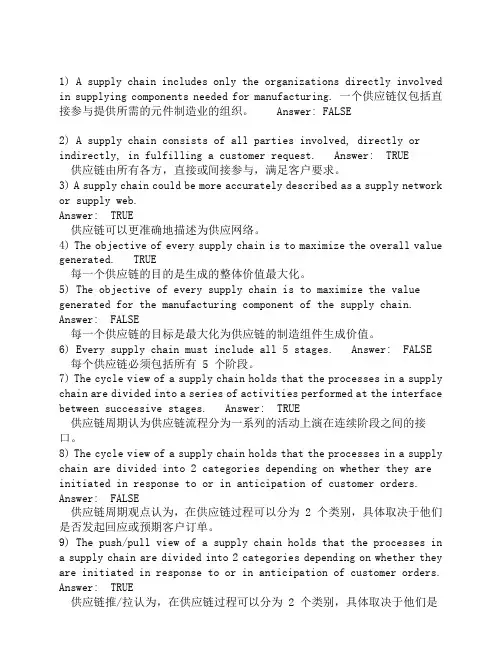
1) A supply chain includes only the organizations directly involvedin supplying components needed for manufacturing.一个供应链仅包括直接参与提供所需的元件制造业的组织。
Answer: FALSE2) A supply chain consists of all parties involved, directly or indirectly, in fulfilling a customer request. Answer: TRUE供应链由所有各方,直接或间接参与,满足客户要求。
3) A supply chain could be more accurately described as a supply network or supply web.Answer: TRUE供应链可以更准确地描述为供应网络。
4) The objective of every supply chain is to maximize the overall value generated. TRUE每一个供应链的目的是生成的整体价值最大化。
5) The objective of every supply chain is to maximize the value generated for the manufacturing component of the supply chain. Answer: FALSE每一个供应链的目标是最大化为供应链的制造组件生成价值。
6) Every supply chain must include all 5 stages. Answer: FALSE每个供应链必须包括所有 5 个阶段。
7) The cycle view of a supply chain holds that the processes in a supply chain are divided into a series of activities performed at the interface between successive stages. Answer: TRUE供应链周期认为供应链流程分为一系列的活动上演在连续阶段之间的接口。
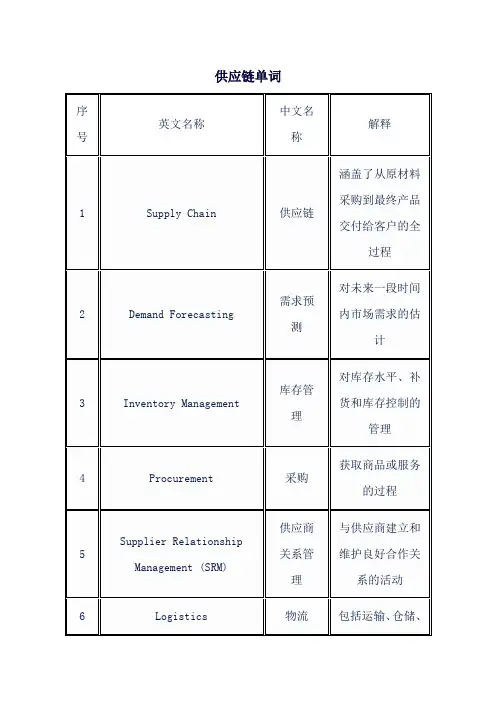
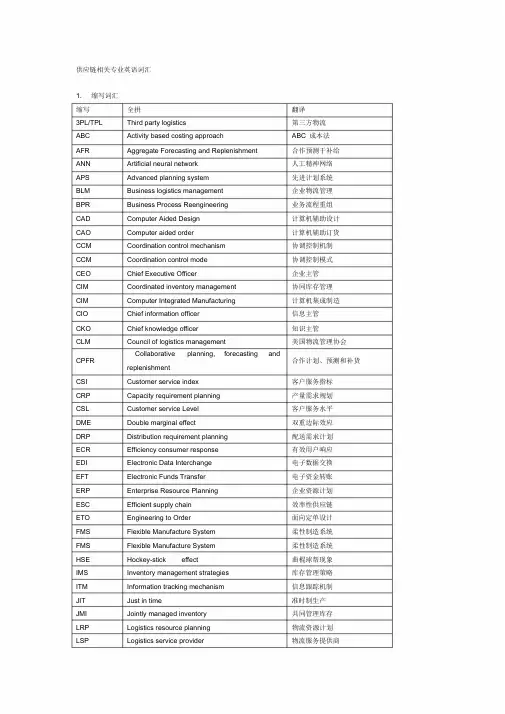
供应链相关专业英语词汇1. 缩写词汇缩写全拼翻译3PL/TPL Third party logistics 第三方物流ABC Activity based costing approach ABC 成本法AFR Aggregate Forecasting and Replenishment 合作预测于补给ANN Artificial neural network 人工精神网络APS Advanced planning system 先进计划系统BLM Business logistics management 企业物流管理BPR Business Process Reengineering 业务流程重组CAD Computer Aided Design 计算机辅助设计CAO Computer aided order 计算机辅助订货CCM Coordination control mechanism 协调控制机制CCM Coordination control mode 协调控制模式CEO Chief Executive Officer 企业主管CIM Coordinated inventory management 协同库存管理CIM Computer Integrated Manufacturing 计算机集成制造CIO Chief information officer 信息主管CKO Chief knowledge officer 知识主管CLM Council of logistics management 美国物流管理协会CPFRCollaborative planning, forecasting andreplenishment合作计划、预测和补货CSI Customer service index 客户服务指标CRP Capacity requirement planning 产量需求规划CSL Customer service Level 客户服务水平DME Double marginal effect 双重边际效应DRP Distribution requirement planning 配送需求计划ECR Efficiency consumer response 有效用户响应EDI Electronic Data Interchange 电子数据交换EFT Electronic Funds Transfer 电子资金转账ERP Enterprise Resource Planning 企业资源计划ESC Efficient supply chain 效率性供应链ETO Engineering to Order 面向定单设计FMS Flexible Manufacture System 柔性制造系统FMS Flexible Manufacture System 柔性制造系统HSE Hockey-stick effect 曲棍球帮现象IMS Inventory management strategies 库存管理策略ITM Information tracking mechanism 信息跟踪机制JIT Just in time 准时制生产JMI Jointly managed inventory 共同管理库存LRP Logistics resource planning 物流资源计划LSP Logistics service provider 物流服务提供商MIS Measuring index system 评价指标体系MPS master production scheduling 主生产排程MRP Material Requirement Planning 物料需求计划MRP ⅡManufacturing Resource Planning 制造资源计划MTO Make to order 按订单生产MTS Make to stock 备货生产NSM Negotiation selection method 协商选择法OEM Original equipment manufacturer 原始设备制造商POS Point of sale 销售终端QFD Quality function development 质量功能开发RSC Responsive supply chain 响应性供应链RSC Revenue sharing contracts 收益共享契约RCCP rough-cut capacity planning 粗能力计划SCC Supply chain coordination 供应链协调SCD Supply chain design 供应链设计SCM Supply chain management 供应链管理SCN Supply chain network 供应链网络SCP Supply chain planning 供应链计划SCP Supply chain partnership 供应链合作关系SFA Sales Forecast Accuracy 预测准确率SKU Stock Keeping Unit 库存进出计量的单位SI Sell in 销售进入渠道SO Sell out 销售给消费者SRM Supplier relationship management 供应商关系管理S&OP Sales and operation planning 销售运营计划TOC Theory of constraint 约束理论TPM Traditional purchase mode 传统采购模式TMS Transportation management system 运输管理系统VMI Vendor Managed Inventory 供应商管理库存WMAPE Weighted Mean Percentage Error 加权平均绝对百分比误差WMS Warehouse management system 仓储管理系统2. 非缩写核心词汇ABC classification ABC 分类Accessory 附件Action Report 行动报告Aggregate Planning .总体规划Agile Manufacturing 灵活制造Allocated Inventory 保留量Alternate BOM 替代物料表Anticipation Inventory 预期库存Assemble to Order 定单组装Automation 自动化Available Inventory 可用库存Available to Promise 可答应量Backlog 待交货Back Order 逾期订单Bill of Labor 人力表BOM Bill of Material 材料表bill of resources 资源表BOM Code 材料表码Bom Explosion 材料表展开Bom Implosion 材料表逆展Bom Structure 材科表结构Built-on-the-Iine parts 线上生产零件Bulk lssue 大批发料Bullwhip Effect 长鞭效应Business Plan 事业计划Capacity 产量Capacity Control 产量控制Capacity requirement planning 产量需求规划Check-in 结入Check-Out 结出Common part Bom 共享件材料表constraint management 限制因素管理continuous production 连续式生产critical capacity 关键产量critical part 关键零件customer order 客户定单customization 客制化customer service level 顾客服务水准cycle count interval 周期盘点区间cycle counting 周期盘点cycle time 周期时间Demand Management 需求管理demonstrated capacity 验证产量iscret manufacturing 装配式生产distribution center 配销中心distribution requirement planning 分销资源计划economic order quantity 经济订购量economic part period 经济量期emergency kanban 紧急看板finished goods 完成品firm planned order 固定计划定单first in first out 先进先出forecast 预测forecast horizon 预测期间fundamental data 基本资料gross requirement 总需求inbound queue control 输入端队列控制independent demand 独立需求input/output control 输入/输出控制intermittent production 问歇式生产inventory management 库存管理inventory status 库存状态inventory type 库存形态job 工件,工作job shop 工件生产工厂just in time 及时供补kanban 看板kanban ceiling 看板界限lead time 前置时间lead time offset 前置时问冲销least total cost 最低总成本批量法least unit cost 最低单位成本批量法level scheduling 平准化排程level production(linearity) 平准化生产linearity 定率生产load 负荷look ahead/look back 瞻前顾后法lot for lot 逐批批量法lot number 批号lot size 批量lot size inventory 批量库存lot sizing rule 批量法则maintenance, repair and operational supplies 间接物料make to order 定单生产make to stock 计划生产manufacturing bom 制造单元manufacturing cell 指令单manufacturing order 制造规划与控制manufacturing planning and control 制造资源规划master production scheduling 主生产排程material requirement planning 材料需求规划(计划)modular bom 模块材料表modular production 模块化生产mps item MPS 项目net requirement 净需求offset time 冲销时问on-hand inventory 在库量on-order inventory 在途量operations planning and control 作业规划与管制operations process chart 作业程序图order interval 订购区间order point 订购点parent/component 父件/子件pan number 件号past due 逾期量peg file 溯源文件pegging 溯源periodic order quantity 定期批量法periodic review system 定期评估法picking order 领料单plan-do-check-action cycle 计划一执行-检查-行动循环planned order receipts 计划定单收料planned order releases 计划定单发出planning bom 计划材料表planning horizon 计划期间planning time fence 计划时栅priority control 优先次序控制prioriry planning 优先次序规划preventive maintenance 预防性维护process manufacturing 流程式生产product family 产品族product line 产品线product structure 产品结构表product sub-line 产品副线production activity control 生产活动管制production rate 生产速率production plan 生产计划production planning 生产规划production run 生产连project-based production 项目式生产projected available balance 预计可用量pull system 拉式系统purchase order 订购单purchase reuisition 请购单quantity-per 单位用量quick response 快速反应rated capacity 评估产量raw material 原材料reasonableness test 合理测试receiving order 收料单refill kanban 补充看板re-order point 再订购点法repetitive manufacturing 重复性生产replacement part 替代件replenishment plan 补充计划replenishment time 补充时间resource requirement planning 资源需求规划rework kanban 重加工看板rolling kanban 滚动看板rolling schedule 滚动式排程rough-cut capacity planning 粗略产量规划safety stock 安全存量safety time 安全时间sales order 销售定单.scheduled receipts 在途量(已订未交货)scarp rate 报废率secondary stockroom 次级仓semi-finished goods 半成品serial number 序号shop calendar 厂历shop floor 制造现场shop floor control 制造现场控制stock keeping unit 材料库存单位subsontract order 外包单supply chain management 供应链管理synchronized control 同步控制synchronized production 同步生产theoretical capacity 理论产量Lime bucket 时段time phased order point 分期间订购点法transferring order 调拨单transportation inventory 运输库存total employee involvement 全员参与total preventive maintenance 全面预防型维护total productive maintenance 全面生产性维护total quality management 全面质量管理unit of measure 单位visual review system 目视评估法where-used report 用途表WIP inventory 在制品库存WIP tracking 在制品追踪work flow control system 工作流程控制系统work-in-process 在制品yield 良品率。
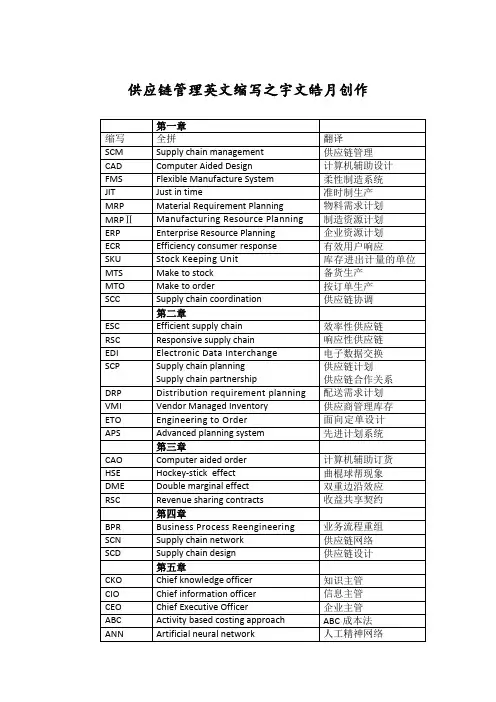
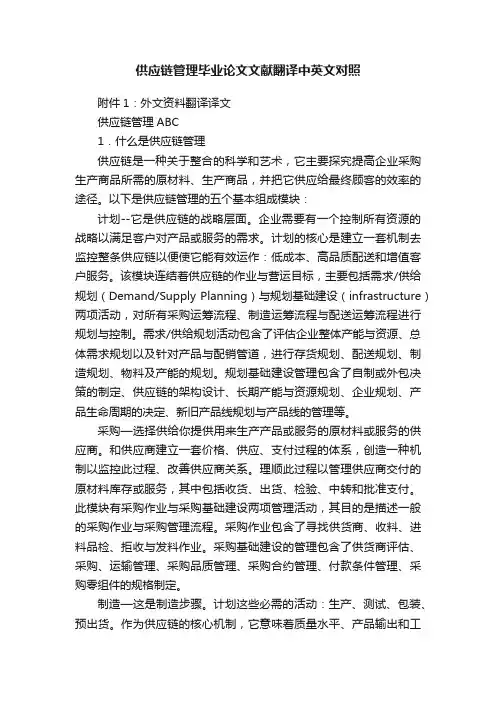
供应链管理毕业论文文献翻译中英文对照附件1:外文资料翻译译文供应链管理ABC1.什么是供应链管理供应链是一种关于整合的科学和艺术,它主要探究提高企业采购生产商品所需的原材料、生产商品,并把它供应给最终顾客的效率的途径。
以下是供应链管理的五个基本组成模块:计划--它是供应链的战略层面。
企业需要有一个控制所有资源的战略以满足客户对产品或服务的需求。
计划的核心是建立一套机制去监控整条供应链以便使它能有效运作:低成本、高品质配送和增值客户服务。
该模块连结着供应链的作业与营运目标,主要包括需求/供给规划(Demand/Supply Planning)与规划基础建设(infrastructure)两项活动,对所有采购运筹流程、制造运筹流程与配送运筹流程进行规划与控制。
需求/供给规划活动包含了评估企业整体产能与资源、总体需求规划以及针对产品与配销管道,进行存货规划、配送规划、制造规划、物料及产能的规划。
规划基础建设管理包含了自制或外包决策的制定、供应链的架构设计、长期产能与资源规划、企业规划、产品生命周期的决定、新旧产品线规划与产品线的管理等。
采购—选择供给你提供用来生产产品或服务的原材料或服务的供应商。
和供应商建立一套价格、供应、支付过程的体系,创造一种机制以监控此过程、改善供应商关系。
理顺此过程以管理供应商交付的原材料库存或服务,其中包括收货、出货、检验、中转和批准支付。
此模块有采购作业与采购基础建设两项管理活动,其目的是描述一般的采购作业与采购管理流程。
采购作业包含了寻找供货商、收料、进料品检、拒收与发料作业。
采购基础建设的管理包含了供货商评估、采购、运输管理、采购品质管理、采购合约管理、付款条件管理、采购零组件的规格制定。
制造—这是制造步骤。
计划这些必需的活动:生产、测试、包装、预出货。
作为供应链的核心机制,它意味着质量水平、产品输出和工厂产能的有效控制。
此模块具有制造执行作业与制造基础建设两项管理活动,其目的是描述制造生产作业与生产的管理流程。
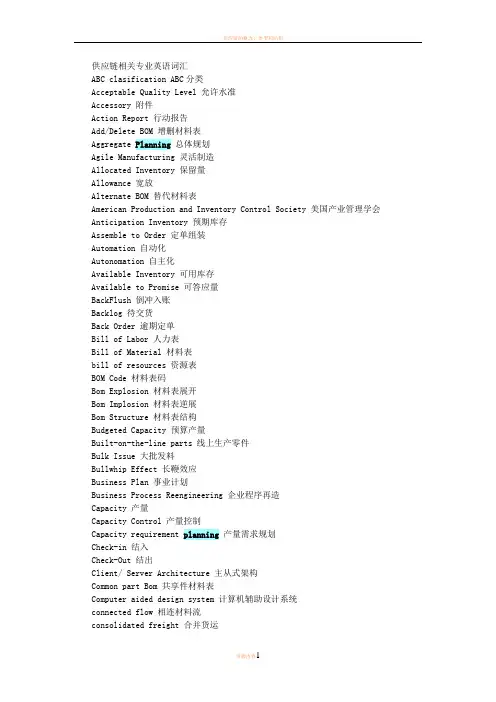
供应链相关专业英语词汇ABC clasification ABC分类Acceptable Quality Level 允许水准Accessory 附件Action Report 行动报告Add/Delete BOM 增删材料表Aggregate Planning总体规划Agile Manufacturing 灵活制造Allocated Inventory 保留量Allowance 宽放Alternate BOM 替代材料表American Production and Inventory Control Society 美国产业管理学会Anticipation Inventory 预期库存Assemble to Order 定单组装Automation 自动化Autonomation 自主化Available Inventory 可用库存Available to Promise 可答应量BackFlush 倒冲入账Backlog 待交货Back Order 逾期定单Bill of Labor 人力表Bill of Material 材料表bill of resources 资源表BOM Code 材料表码Bom Explosion 材料表展开Bom Implosion 材料表逆展Bom Structure 材料表结构Budgeted Capacity 预算产量Built-on-the-line parts 线上生产零件Bulk Issue 大批发料Bullwhip Effect 长鞭效应Business Plan 事业计划Business Process Reengineering 企业程序再造Capacity 产量Capacity Control 产量控制Capacity requirement planning产量需求规划Check-in 结入Check-Out 结出Client/ Server Architecture 主从式架构Common part Bom 共享件材料表Computer aided design system 计算机辅助设计系统connected flow 相连材料流consolidated freight 合并货运constraint management 限制因素管理continuous improvement 连续改善continuous production 连续式生产critical capacity 关键产量critical part 关键零件customer order 客户定单customization 客制化customer service level 顾客服务水准cycle count interval 周期盘点区间cycle counting 周期盘点cycle time 周期时间customer relationship management 客户关系管理data flow diagram 数据流程图de-coupling stock 反耦合库存Demand Management 需求管理Demand Rate 需求速率Demand time fence 需求时栅demonstrated capacity 验证产量dependent demand 依赖需求diagnostic test 诊断测试disconnected flow 分离材料流iscret manufacturing 装配式生产distribution center 配销中心distribution requirement planning配销需求规划drum-buffer-rope control DBR管制法earliest start date 最早开工日economic order quantity 经济订购量economic part period 经济量期elimination,combination,rearrangement,simplification ECRS改善法emergency kanban 紧急看板employee empowerment 员工授权employee involvement 员工参与end user computing 使用者自建系统engineering to order 定单设计engineering change 设计变更engineering product structure 工程用产品结构表exception report 企业资料规划enterprise resource planning例外报告executive information system 主管信息系统existence test 存在测试expeditor 催料人员final assembly schedule 最终组装排程finished goods 完成品firm planned order 固定计划定单first in first out 先进先出fixed order quantity 定量批量法flow shop 流程生产工厂forecast 预测forecast horizon预测期间fundamental data 基本资料gateway workstation 投料工作站graphic user interface 图形接口gross requirement 总需求group technology 群组技术hedge inventory 避险库存inbound queue control 输入端队列控制independent demand 独立需求input/output control 输入/输出控制intermittent production 间歇式生产inventory management 库存管理inventory status 库存状态inventory sub-type 库存副型态inventory type 库存型态item 材料(项目)item master 材料主档job 工件,工作job shop 工件生产工厂joint operation 联合作业just in time 及时供补kanban 看板kanban ceiling 看板界限latest start date 最晚开工日lead time 前置时间lead time offset 前置时间冲销least total cost 最低总成本批量法least unit cost 最低单位成本批量法level scheduling 平准化排程level production(linearity) 平准化生产linearity 定率生产load 负荷look ahead/look back 瞻前顾后法lot for lot 逐批批量法lot number 批号lot size 批量lot size inventory 批量库存lot sizing rule 批量法则low-level code 最低阶码maintenance, repair and operational supplies 间接物料make to order 定单生产make to stock 计划生产managerial product structure 管理用产品结构表manufacturing bom 制造单元manufacturing cell 制令单manufacturing order 制造规划与控制manufacturing planning and control 制造资源规划master production scheduling 主生产排程master scheduler 主生产排程员material service sheduling 主服务排程material handling 材料搬运material requirement planning材料需求规划(计划) mean absolute deviation 平均绝对差modular bom 模块材料表modular production 模块化生产mps item MPS 项目mrp crusades MRP 改革运动mrp nervousness MRP不安定性multilevel mps 多阶主生产排程net change 净变法net requirement 净需求offset time 冲销时间one less at a time 一次减一点on-hand inventory 在库量on-order inventory 在途量open system platform 开放系统平台operations planning and control 作业规划与管制operations process chart 作业程序图option 选用件optional bom 选用材料件order interval 订购区间order point 订购点original equipment manuafacturer 原设备制造商outbound queue control 输出端队列控制overflow stockroom 溢量仓parent/component 父件/子件part number 件号part periodic balancing 量期平衡批量法past due 逾期量peg file 溯源文件pegging 溯源period length 期长periodic order quantity 定期批量法periodic review system 定期评估法phantom 幽灵材料phantom bom 幽灵材料表phantom component 幽灵子件picking order 领料单pipeline stock 管路库存plan-do-check-action cycle 计划-执行-检查-行动循环planned order receipts 计划定单收料planned order releases 计划定单发出planning bom 计划材料表planning horizon计划期间planning time fence 计划时栅point of use 使用点primary stockroom 基本仓priority control 优先次序控制priority planning优先次序规划preventive maintenance 预防性维护process flow chart 制程流程图process manufacturing 流程式生产product configuration system 产品构造系统product family 产品族product line 产品线product load profile 产品负荷表product structure 产品结构表product sub-line 产品副线production activity control 生产活动管制production rate 生产速率production plan 生产计划production planning生产规划production run 生产连project-based production 项目式生产projected available balance 预计可用量projected on-hand 预计在库量pseuo bom 假材料表pull signal 拉式讯号pull system 拉式系统purchase order 订购单purchase reuisition 请购单quantity-per 单位用量quick response 快速反应rated capacity 评估产量raw material 原材料reasonableness test 合理测试receiving order 收料单refill kanban 补充看板regeneration 再生法re-order point 再订购点法repetitive manufacturing 重复性生产replacement part 替代件replenishment plan 补充计划replenishment time 补充时间resource profile 资源负荷表resource requirement planning资源需求规划rework kanban 重加工看板rolling kanban 滚动看板rolling schedule 滚动式排程rough-cut capacity planning粗略产量规划route 途程routing 途程表safety stock 安全存量safety time 安全时间safety order 销售定单scheduled receipts 在途量(已订未交量) scarp rate 报废率secondary stockroom 次级仓semi-finished goods 半成品serial number 序号setup 准备作业shop calendar 厂历shop floor 制造现场shop floor control 制造现场控制shop order 制令单significant numbering 显义编号standard coefficient 标准系数stock keeping unit 材料库存单位subsontract order 外包单super bom 超材料单supply chain management 供应链管理synchronized control 同步控制synchronized production 同步生产theoretical capacity 理论产量theory of constraints 限制理论three tier architecture 三层式架构throughtput 产出率time bucket 时段time phased order point 分期间订购点法transferring order 调拨单transportation inventory 运输库存total employee involvement 全员参与total preventive maintenance 全面预防性维护total productive maintenance 全面生产性维护total quality management 全面质量管理two bin system 双箱法two level mps 双阶主生产排程unit of measure 单位visual review system 目视评估法where-used report 用途表WIP inventory 在制品库存WIP tracking 在制品追踪work flow control system 工作流程控制系统work-in-process 在制品yield 良品率。

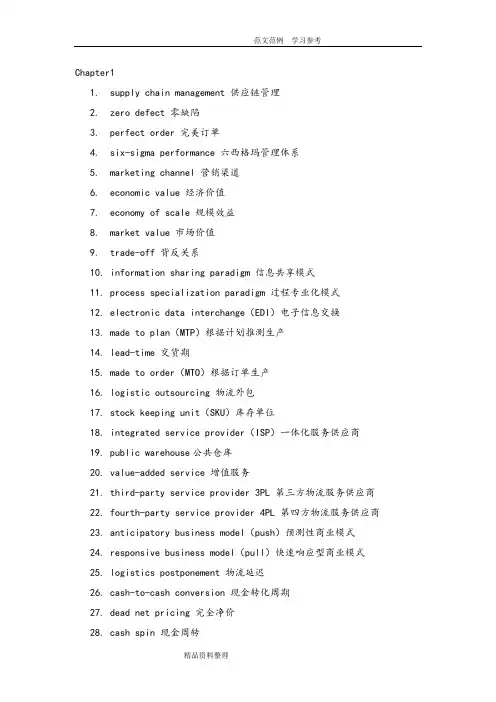
Chapter11.supply chain management 供应链管理2.zero defect 零缺陷3.perfect order 完美订单4.six-sigma performance 六西格玛管理体系5.marketing channel 营销渠道6.economic value 经济价值7.economy of scale 规模效益8.market value 市场价值9.trade-off 背反关系rmation sharing paradigm 信息共享模式11.process specialization paradigm 过程专业化模式12.electronic data interchange(EDI)电子信息交换13.made to plan(MTP)根据计划推测生产14.lead-time 交货期15.made to order(MTO)根据订单生产16.logistic outsourcing 物流外包17.stock keeping unit(SKU)库存单位18.integrated service provider(ISP)一体化服务供应商19.public warehouse公共仓库20.value-added service 增值服务21.third-party service provider 3PL 第三方物流服务供应商22.fourth-party service provider 4PL 第四方物流服务供应商23.anticipatory business model(push)预测性商业模式24.responsive business model(pull)快速响应型商业模式25.logistics postponement 物流延迟26.cash-to-cash conversion 现金转化周期27.dead net pricing 完全净价28.cash spin 现金周转29.operational performance 运作绩效30.order processing 订单处理31.customer accommodation 市场分销Chapter2 Inbound logistics 采购运筹,进口物流1.Procurement perspective and strategies 采购远景和策略2.continuous supply 持续供应3.minimize inventory investment 减少存货投资-JIT4.quality improvement 质量改进5.lowest total cost of ownership-TCO 所有权总成本最低6.supplier-buyer integration 供方买方整合7.value management 价值管理8.sales synergy 销售协同9.Manufacturing perspective and strategies 生产远景和策略10.brand power 品牌力11.Lead time 备货期12.Make-to-stock(MTS)备货型生产13.Make-to-order(MTO)订货型生产14.Assemble-to-order(ATO)面向订单装配15.Material Requirement Planning(MRP) 物料需求计划Chapter3 Outbound Logistics 出货物流1.Supply chain service output 供应链营运功率2.Spatial convenience 空间便利性3.Lot size 批量4.Waiting time 等待时间5.Stock out frequency 缺货率6.Fill rate 供应比率7. Sales and operations planning 销售和运作计划8.Order shipped complete 订货完成率9.Operation Performance 运行性能:10.Service Reliability 服务可靠性11.Customer Satisfaction 顾客满意度:12.Value added service 增值业务:13.Customer-focused services顾客导向之服务14.Promotion-focused services促销导向之服务15.Manufacturing-focused services 生产导向之服务16.Time-based services 基于时间的服务17.Distribution Resource Planning (DRP) 配送资源计划18.Total Quality Management全面质量管理19.customer relationship management(CRM)客户关系管理20.International Organization for Standardization(ISO)国际标准化组织21.European Article Numbering(EAN)欧洲物品编码22.Total Cost of Ownership所有权的总成本23.Economic Order Quantity(EOQ)经济订货量24.authorized economic operator授权经济运营25.make-to-plan(MTP)计划型生产26.Assemble-to-order面向订单装配27.materials requirements planning(MRP)物料需求计划28.performance-based logistics基于性能的物流29.Master Production Schedule主生产计划30.Bill of Materials 物料清单31.Distribution Resource Planning分销资源计划32.Supply chain information systems 供应链信息系统33.Enterprise Resource Planning(ERP)企业资源规划34.transportation management system运输管理系统35.Warehouse management system存货管理系统36.Yard management system堆场管理系统Advanced Planning and Scheduling(APS) 高级计划与排程系统37. available to promise 可行性承诺38.Collaborative Planning, Forecasting and Replenishment(CPFR)协同规划,预测和补货39.bills of lading提单40. proof of delivery交货证明Chapter4Geographical specialization 地域专门化Decoupling 库存的“分离”作用Balancing supply and demand 平衡供需Buffering uncertainty 降低不确定性因素Service lever 服务水平Average inventory 平均库存Inventory policy 存货政策Cycle inventory, or base stock 周转库存Safety stock inventory 安全库存Transit inventory 在途库存Order quantity 订购数量Transit inventory 已中转存货Obsolete inventory陈旧存货Speculative inventory投机性存货Safety stock 安全储备Reorder point 再订货点Inventory turns库存周转次数performance cycle or lead time绩效循环Inventory carrying cost 库存持有成本Volume Transportation Rates体积运输率Free On board (FOB) 船上交货价Quantity Discount大批量折扣Other EOQ Adjustments其他存货调整Demand uncertainty 需求的不确定性Performance cycle uncertainty 运行周期的不确定性Standard deviation 标准差Poisson distribution 泊松分布Safety Stock with Combined Uncertainty安全库存结合的不确定性Numerical compounding 精确合成Estimating Fill Rate估计填充率Dependent Demand Replenishment相关需求补给Safety time 安全时间Over planning top-level demand 对高水平需求的超额预测Inventory control 库存控制Perpetual Review 永续盘存Periodic Review 定期盘存Reactive inventory system 反应式库存系统Pull inventory system 拉动式库存系统Fair Share Allocation 公平份额分配法Distribution Requirements Planning (DRP) 配送需求计划Collaborate Inventory Replenishment 联合库存补充Vendor-Managed Inventory (VMI) 供应商管理存货Profile Replenishment (PR) 系列补货Product Classification Analysis (ABC) 产品分类分析Product/Market Classification 产品/市场分类Segment Strategy Definition 战略定义Policies and Parameters 政策和参数Chapter5,6(第八、九、十章)第八章Transportation InfrastructureIn-transit inventory在途库存Diversion转移Economy of scale规模经济 economy of distance 距离经济Tapering principle 远距离递减原则Consignor 发货人 consignee 收货人United States Postal Service (USPS)美国邮政服务Department of Transportation(DOT)运输部门Interstate Commerce Commission (ICC) 洲际商会Surface Transportation Board (STB) 陆地运输局Rights-of-way 通行权Ton-mile 吨英里Truckload(TL) 整车运输less—than—truckload(LTL) 零担运输specialty 专项运输North America Free Trade Agreement (NAFTA) 北美自由贸易协定Central America Free Trade Act (CAFTA) 中美洲自由贸易法United Parcel Service (UPS) 联合包裹运输服务公司Piggyback service 驼背式运输服务Land bridge 大陆桥Freight forwarders 货运代理人第九章Transportation OperationsStowability 装载能力Hundredweight (CWT) 英担Transport lane 运输通道Back-haul 可带回去Deadheaded 空车返回Variable costs 可变成本Fixed costs 固定成本Joint costs 连带成本Common costs公共成本Cost-of-service 服务成本策略Value-of-service 服务价值策略Combination pricing strategy 组合定价策略Net-rate pricing 净费率定价策略Tariff 费率表Class rate 费率类别Minimum charges and surcharges最低收费和附加费Commodity rate 商品费率Exception rates 特价费率Aggregate tender rate累计费率Limited service rate 有限服务费率Shipper load and count rate 发货人装载和清点费率Released value rate 免责价值费率Freight-all-kind (FAK) rates 均价费率Local rate 地方费率Single-line rate单线费率Joint rate 联合费率Proportional rate比例费率Transit service 转运服务Diversion and reconsignment 转移并变更收货人Split delivery 分票交付Demurrage 滞期费Detention 滞留费用Special or accessorial service 特别的或者附属的费用Special equipment charges 特殊设备使用费Transportation management system (TMS)运输管理系统Core carrier strategy 核心承运人战略Integrated service providers (ISPs)Reactive and proactive反应性和主动性Market area 市场范围法Scheduled area delivery 定期运送Pooled delivery集中运送Preorder planning 预订计划Multi-vendor consolidation 多卖主集拼Expediting 加急Hours of service(HOS) 服务时间Federal Motor Carrier Safety Administration联邦汽车运输安全管理局Loss or damage 货物丢失和损伤Overcharge/undercharge索价过低Preaudit 事前审核Post audit 事后审核Bill of lading 提货单Order-notified 待命提单Freight bill运费账单Prepaid or collect 预付或到付Shipment manifest装货清单Free on board船上交货Freight on board 离岸价格F.O.B. Origin FOB原产地价格F.O.B. Destination pricing FOB交货地价格F.O.B. 离岸价Delivered pricing 交货价Single-zone delivered pricing单地区定价Multiple-zone delivered pricing多地区定价Base—point pricing system基点定价系统Phantom freight在售价上加计的运费Freight absorption 运费免收Substantially lessen competition 大大减少竞争Forward-buy 提前购买Every Day Low Pricing(EDLP)天天低价Activity-based costing 作业成本法Total cost-to-serve model总成本与服务模型第十章 WarehousingDistribution center 分销中心Just-in-time (JIT)准时制生产Cross-docking 越库式转运Mixing组合作业Assembly 装配作业Lead suppliers or tier one suppliers 主供应商或一级供应商Environmental Protection Agency(EPA)环境保护机构Food and Drug Administration(FDA)食品药物监管会Occupational Safety and Health Administration(OSHA)职业安全与卫生管理局Spot-stocked 定点储存Value-added services(VAS)增值服务Transfer and selection 货物的转移和分拣作业Flow-through or cross-dock distribution通过式配送或越库式转运Extended storage 长期储存Contract warehousing 合同仓储Selection or picking area 分拣作业的区域Discrete selection and wave selection 单独分拣和区域分拣Batch selection 批次挑选Chapter 7 Integrated Operations PlanningSupply Chain Planning供应链计划Supply chain visibility供应链的可见性Simultaneous resource consideration资源的同步考虑Resource utilization资源的利用率Supply Chain Planning Applications供应链计划应用系统Demand Planning需求计划Product Planning生产计划Logistics Planning 物流计划Sales and Operations Planning (S&OP)销售和作业计划系统Maximize production产量最大化Stable schedule稳定的生产进度Long lead times长的提前期Lower margins较低的利润Aggregate forecasts总体预测Rapid response 快速响应Maximize revenue 利润最大化Collaborative planning协同计划Exponential smoothing指数平滑法extended exponential smoothing扩展平滑法Adaptive smoothing调节性平滑法Multiple regression多元回归Chapter 8 Global Supply ChainGlobal Supply Chain Integration全球供应链一体化Stages of international development国际化发展的阶段Use restriction使用限制Price surcharges价格附加费Local presence本地经营Global Sourcing 国际采购Rationale for Low-Cost-Country sourcing低成本国家采购的理由Guidelines for sourcing采购的指导方针Achieve economies of scale实现规模经济Reduce direct cost减少直接成本Reduce market access uncertainty减少市场准入的不确定性Enhance sustainability增强可持续性Combined transport document联运单据Commercial invoice商业发票Insurance certificate保险证书Certificate of origin原产地证书Logistics Performance Index(LPI)物流绩效指数Chapter 9 Chapter 10(第十五、十六章)SDWT--self-directed work teams 自我指导工作小组Balanced scorecards 平衡计分卡Balance sheet 资产负债表Income statement 利润表The great divide 严重断层Reliability-based trust 以可靠性为基础的信任Character-based trust 以特性为基础的信任Average order cycle time 平均订货周期时间Order cycle consistency 订货周期一致性On-time delivery 准时交货Downtime 停工期Inventory turnover rate 库存周转率ROA---return on assets 资产回报率ROI---return on investment 投资回报率RONW---return on net worth 净值回报率Contribution approach 贡献毛利法Net profit approach 净利润法SPM---Strategic Profit Model 战略盈利模型CMROI---contribution margin return on inventory investment库存投资利润贡献率。
中英文在线翻译The three flows of a supply chain 供应链的三种“流”Supply chain management (SCM) is concerned with the integration, coordination and control of the flow of material, information and finances in supply chains.供应链管理(SCM)涉及到对供应链中材料流、信息流和资金流所进行的整合、协调和控制。
SCM can be divided into three main flows:❝The product flow or materials flow includes moving goods from supplier to consumer as well as dealing with customer service needs.❝The information flow includes order information and delivery status.❝The financial flow includes payments schedules, credit terms and additional arrangements.SCM分为三个主要的流:❝产品流或材料流包括包括商品从供应商向客户的移动,也包括处理客户的服务需求。
❝信息流包括订单信息及交付状况。
❝金流包括付款时间安排表,赊账条款以及追加安排❝The Bullwhip Effect“牛鞭效应”❝The bullwhip effect (or whiplash effect) is an observed phenomenon in forecast-driven distribution channels. It refers to a trend of larger and larger swings in inventory in response to changes in demand. The concept first appeared in Jay Forrester's Industrial Dynamics (1961) and thus it is also known as the Forrester effect.Since the oscillating demand upstream a supply chain is reminiscent of a cracking whip, it became known as the bullwhip effect.❝“牛鞭效应”或“鞭抽效应”是在预测驱动型流通渠道中的一种已观察到的现象。
供应链管理外文翻译Supply Chn ManagementIntroduction Supply chn management (SCM) is the strategic and operational management of the series of processes involved in moving a product or service from concept to final consumption. It includes the coordination and integration of supply, demand, raw materials, production, distribution, and最终 consumption. The goal of SCM is to create a seamless flow of information, materials, and finances from suppliers to customers, increasing efficiency, reducing costs, and improving service. Key Concepts1、Supply Chain: The series of businesses and organizations that are involved in the production and delivery of a product or service, including suppliers, manufacturers, warehouses, transportation companies, and retailers.2、Demand Management: The process of forecasting and managing customer demand to ensure that supply meets demand. This involves analyzing sales data, market research, and communication with customers to understand their needs.3、Logistics Management: The coordination and management of the transportation, storage, and inventory of goods from suppliers to customers. Logistics management aims to optimize transportation costs, reduce inventory, and ensure on-time delivery.4、Procurement Management: The process of purchasing the raw materials, components, and services required for production. It involves developing relationships with suppliers, negotiating prices, and ensuring quality and delivery.5、Information Management: The process of collecting, sharing, and using information throughout the supply chain. This includes the flow of orders, shipments, payments, and product information between businesses.6、Collaboration: The cooperation and communication between supply chain partners to achieve shared goals. This requires open communication, trust, and the sharing of data and resources.7、Continuous Improvement: The practice of constantly seeking to improve processes, reduce waste, and increase efficiency. It requires regular analysis of supply chain performance dataand the implementation of effective changes based on identified opportunities for improvement.Benefits SCM can provide significant benefits to businesses and their customers:1、Improved Efficiency: By optimizing supply chain processes and removing bottlenecks, SCM can increase operational efficiency and reduce costs.2、Enhanced Customer Satisfaction: SCM ensures that products are delivered promptly, accurately, and to the desired quality standards, resulting in satisfied customers.3、Increased Flexibility: SCM allows businesses to quickly adapt to changes in market conditions, customer demand, and supply.4、Reduced Risk: SCM improves the visibility and manageability of supply chain operations, which helps businesses identify and address potential risks before they become problems.5、Enhanced Competitiveness: Effective SCM can help businesses reduce costs, improve delivery times, and provide better quality products, which can provide a competitive advantage inthe market.Conclusion Supply chn management is critical for businesses today as it involves the entire process of moving products or services from concept to final consumption. By optimizing supply chn processes, improving collaboration, and continuously seeking improvement, businesses can achieve increased efficiency, customer satisfaction, flexibility, reduced risk, and enhanced competitiveness. Therefore, effective SCM is essential for businesses to remn competitive in today's rapidly changing global marketplace.。
供应链英语描述In the modern era of globalization, supply chain management has become a crucial aspect of any business operation. It involves the coordination of activities across multiple organizations, from suppliers to end customers, to ensure the efficient flow of goods and services. This integrated process encompasses procurement, production, logistics, sales, and customer service, all of which must work in harmony to maximize value and minimize waste.The supply chain begins with suppliers, who provide raw materials and components necessary for production.Effective supplier management involves evaluating and selecting reliable partners, negotiating contracts, and monitoring performance to ensure timely delivery of quality products. Strong supplier relationships are essential for maintaining the stability and efficiency of the supply chain.Production is the next phase, where raw materials are transformed into finished goods. This process requires careful planning and execution, taking into account factorssuch as capacity, demand, and lead times. Effective production management ensures that products are made efficiently, cost-effectively, and to the required quality standards.Logistics, which includes transportation, warehousing, and distribution, is crucial for getting products to customers. Efficient logistics systems minimize transportation costs, reduce inventory holding costs, and ensure timely delivery. The use of advanced technologies like just-in-time delivery, lean logistics, and supply chain analytics can further optimize the logistics process. Sales and customer service are the final links in the supply chain, where businesses engage directly with customers. Effective sales and customer service strategies enhance customer satisfaction and loyalty, driving revenue growth and profitability. A responsive customer service team can also help identify and address issues in the supply chain, improving overall performance.In today's dynamic business environment, supply chain management must be agile and responsive to changes in demand, supply, and market conditions. The integration ofadvanced technologies like artificial intelligence, blockchain, and the Internet of Things is transforming supply chain management, enabling real-time tracking and tracing, predictive analytics, and improved decision-making. However, supply chain management also faces challenges such as risks associated with supplier failure, natural disasters, and geopolitical events. Effective risk management strategies, including diversification of suppliers, contingency planning, and resilience building, are crucial for mitigating these risks and ensuring the continuity of the supply chain.In conclusion, supply chain management is a complex yet critical aspect of modern business operations. It requiresa holistic approach, encompassing all stages of the supply chain from suppliers to customers. By leveraging advanced technologies and implementing effective risk management strategies, businesses can optimize their supply chains, drive growth, and enhance customer satisfaction in a globalized world.**供应链管理:全球视角**在全球化的现代时代,供应链管理已成为任何业务运营的关键方面。
供应链管理外文翻译文献供应链管理外文翻译文献(文档含中英文对照即英文原文和中文翻译)Supply Chain ManagementThe so-called supply chain, in fact, from suppliers, manufacturers, warehouses, istribution centers and channels, and so constitute a logistics network. The same enterprise may constitute the different components of this network node, but the situation is different from a corporate network in different nodes. For example, in a supply chain, companies may not only in the same manufacturers, storage nodes, and in distribution centers, such as possession node location. In the more detailed division of labor, the higher the rofessional requirements of the supply chain, different nodes are basically composed by different enterprises. In the supply chain flows between the member units of raw materials, finished products, such as inventory and production constitutes the supply chain of goods flow.That is, to meet a certain level of customer service under the conditions, in order to make the whole supply chain to minimize costs and the suppliers, manufacturers, warehouses, distribution centers and channels, and so effectively organized together to carry out Product manufacturing, transport, distribution and sales management.From the above definition, we can be interpreted to include supply chain anagement of rich content.First of all, supply chain management products to meet customer demand in the process of the cost implications of various members of the unit are taken intoaccount, including from raw material suppliers, manufacturers to the warehouse distribution center to another channel. However, in practice in the supply chain analysis, it is necessary to consider the supplier's suppliers and customers of the customers, because their supply chain performance is also influential.Second, supply chain management is aimed at the pursuit of the whole supply chain's overall efficiency and cost effectiveness of the system as a whole, always trying to make the total system cost to a minimum. Therefore, the focus of supply chain management is not simply a supply chain so that members of the transportation costs to minimize or reduce inventory, but through the use of systems approach to coordinate the supply chain members so that the entire supply chain total cost of the minimum so that the whole supply chain System in the most fluent in the operation.Third, supply chain management is on the suppliers, manufacturers, warehouses, distribution centers and organically integrate the channel into one to start this problem, so many businesses, including its level of activities, including the strategic level, tactical and operational level Level, and so on.Although the actual logistics management, only through the organic supply chain integration, enterprises can significantly reduce costs and improve service levels, but in practice the supply chain integration is very difficult, it is because: First of all, in the supply chain There are different members of different and conflicting objectives. For example, providers generally want manufacturers to purchase large quantities of stable, and flexible delivery time can change; desire to the contrary with suppliers, although most manufacturers are willing toimplement long-term production operations, but they must take into account the needs of its customers and to make changes Positive response, which requires manufacturers choice and flexibility in procurement strategy. Therefore, suppliers and manufacturers to the goal of flexibility in the pursuit of the objectives inevitably exist between the contradictions.Secondly, the supply chain is a dynamic system, with time and constantly changing. In fact, customers not only demand and supply capacity to change over time, supply chain and the relationship between the members will change over time. For example, the increased purchasing power with customers, suppliers and manufacturers are facing greater pressure to produce more and more personalized varieties of high-quality products, then ultimately the production of customized products.Research shows that effective supply chain management can always make the supply chain of enterprises will be able to maintain stability and a lasting competitive advantage, thus increasing the overall supply chain competitiveness. Statistics show that, supply chain management will enable the effective implementation of enterprise total cost of about 20 per cent decline in the supply chain node on the enterprise-time delivery rate increased by 15 percent or more, orders to shorten the production cycle time 20 percent to 30 percent, supply chain Node on the enterprise value-added productivity increased by 15 percent or more. More and more enterprises have already recognized that the implementation of supply chain management of the great benefits, such as HP,IBM, DELL, such as supply chain management in the practice of the remarkable achievements made is proof.Supply chain management: it from a strategic level and grasp the overall perspective of the end-user demand, through effective cooperation between enterprises, access from the cost, time, efficiency, flexibility, and so the best results. From raw materials to end-users of all activities, the whole chain of process management.SCM (supply chain management) is to enable enterprises to better procurement of manufactured products and services required for raw materials, production of goods and services and their delivery to clients, the combination of art and science. Supply chain management, including the five basic elements.Plan: This is a strategic part of SCM. You need a strategy to manage all the resources to meet our customers for your products. Good plan is to build a series of methods to monitor the supply chain to enable it to effective, low-cost delivery of high quality for customers and high-value products or services.Procurement: you can choose the products and services to provide goods and services providers, and suppliers to establish a pricing, delivery and payment processes and create methods to monitor and improve the management, and the suppliers to provide goods and services Combined with management processes, including the delivery and verification of documentation, transfer of goods to your approval of the manufacturing sector and payments to suppliers and so on.Manufacturing: arrangements for the production, testing, packaged and ready for delivery, supply chain measurement is the largest part of the contents, including the level of quality, product yield and productivity of workers, such as the measurement.Delivery: a lot of "insider" as "logistics", is to adjust the user's orders receipts, the establishment of the storage network, sending and delivery service delivery personnel to the hands of customers, the establishment of commodity pricing system, receiving payments.Return: This is the supply chain problems in the handling part. Networking customers receive the refund of surplus and defective products, and customer applications to provide support for the problem.Source70 in the late 20th century, Keith Oliver adoption and Skf, Heineken, Hoechst, Cadbury-Schweppes, Philips, and other contact with customers in the process of gradually formed its own point of view. And in 1982, "Financial Times" magazine in an article on the supply chain management (SCM) of the significance, Keith Oliver was that the word will soon disappear, but "SCM" not only not disappeared, and quickly entered the public domain , The concept of the managers of procurement, logistics, operations, sales and marketing activities sense a great deal.EvolutionSupply chain has never been a universally accepted definition, supply chain management in the development process, many experts and scholars have putforth a lot of definition, reflecting the different historical backgrounds, in different stages of development of the product can be broadly defined by these For the three stages:1, the early view was that supply chain is manufacturing enterprises in an internal process2, but the supply chain concept of the attention of the links with other firms 3, the last of the supply chain concept of pay more attention around the core of the network links between enterprises, such as core business with suppliers, vendors and suppliers, and even before all the relations, and a user, after all the users and to the relationship.ApplySupply chain management involves four main areas: supply, production planning, logistics, demand. Functional areas including product engineering, product assurance, procurement, production control, inventory control, warehouse management, distribution management. Ancillary areas including customer service, manufacturing, design engineering, accounting, human resources, marketing.Supply Chain Management implementation steps: 1, analysis of market competition environment, identify market opportunities, 2, analysis of customer value, 3, identified competitive strategy, 4, the analysis of the core competitiveness of enterprises, 5, assessment, selection of partners For the supply chain partners of choice, can follow the following principles:1, partners must have available the core of their competitiveness.2, enterprises have the same values and strategic thinking3, partners must Fewer but Better.CaseAs China's largest IT distributor, Digital China in China's supply chain management fields in the first place. In the IT distribution model generally questioned the circumstances, still maintained a good momentum of development, and CISCO, SUN, AMD, NEC, IBM, and other famous international brands to maintain good relations of cooperation. e-Bridge trading system in September 2000 opening, as at the end of March 2003, and 6.4 billion yuan in transaction volume. In fact, this is the Digital China from the traditional distribution supply chain services to best reflect the changes. In the "distribution of services is a" concept, Digital China through the implementation of change channels, expansion of product and service operations, increasing its supply chain in the value of scale and specialized operations, to meet customer demand on the lower reaches of the In the course of the supply chain system can provide more value-added services, with more and more "IT services" color.供应链管理所谓供应链,其实就是由供应商、制造商、仓库、配送中心和渠道商等构成的物流网络。
Supply Chain Management供应链管理The so-called supply chain, in fact, from suppliers, manufacturers, warehouses, distribution centers and channels, and so constitute a logistics network. The same enterprise may constitute the different components of this network node, but the situation is different from a corporate network in different nodes. For example, in a supply chain, companies may not only in the same manufacturers, storage nodes, and in distribution centers, such as possession node location. In the more detailed division of labor, the higher the professional requirements of the supply chain, different nodes are basically composed by different enterprises. In the supply chain flows between the member units of raw materials, finished products, such as inventory and production constitutes the supply chain of goods flow.所谓供应链,其实就是由供应商、制造商、仓库、配送中心和渠道商等构成的物流网络。
1) A supply chain includes only the organizations directly involved in supplying components needed for manufacturing.一个供应链仅包括直接参与提供所需的元件制造业的组织。
Answer: FALSE2) A supply chain consists of all parties involved, directly or indirectly, in fulfilling a customer request. Answer: TRUE供应链由所有各方,直接或间接参与,满足客户要求。
3) A supply chain could be more accurately described as a supply network or supply web. Answer: TRUE供应链可以更准确地描述为供应网络。
4) The objective of every supply chain is to maximize the overall value generated. TRUE每一个供应链的目的是生成的整体价值最大化。
5) The objective of every supply chain is to maximize the value generated for the manufacturing component of the supply chain. Answer: FALSE每一个供应链的目标是最大化为供应链的制造组件生成价值。
6) Every supply chain must include all 5 stages. Answer: FALSE每个供应链必须包括所有 5 个阶段。
7) The cycle view of a supply chain holds that the processes in a supply chain are divided into a series of activities performed at the interface between successive stages. Answer: TRUE供应链周期认为供应链流程分为一系列的活动上演在连续阶段之间的接口。
8) The cycle view of a supply chain holds that the processes in a supply chain are divided into 2 categories depending on whether they are initiated in response to or in anticipation of customer orders. Answer: FALSE供应链周期观点认为,在供应链过程可以分为 2 个类别,具体取决于他们是否发起回应或预期客户订单。
9) The push/pull view of a supply chain holds that the processes in a supply chain are divided into 2 categories depending on whether they are initiated in response to or in anticipation of customer orders. Answer: TRUE供应链推/拉认为,在供应链过程可以分为 2 个类别,具体取决于他们是否发起回应或预期客户订单。
10) The push/pull view of a supply chain holds that the processes in a supply chain are divided into a series of activities performed at the interface between successive stages. FALSE供应链推/拉认为在供应链流程分为一系列的活动上演在连续阶段之间的接口。
11) The objective of the customer arrival process is to maximize the conversion of customer arrivals to customer orders. Answer: TRUE客户到达过程的目标是最大化客户来港定居人士对客户订单的转换。
12) The objective of the customer arrival process is to ensure that orders are quickly and accurately entered and communicated to other affected supply chain processes. FALSE客户到达过程的目标是确保订单是快速、准确地输入,并传达给其他受影响的供应链流程。
13) The objective of customer order entry is to ensure that orders are quickly and accurately entered and communicated to other affected supply chain processes. Answer: TRUE客户订单输入的目标是确保订单是快速、准确地输入,并传达给其他受影响的供应链流程。
14) The objective of customer order entry is to maintain a record of product receipt and complete payment. Answer: FALSE客户订单输入的目标是保持产品收据和完成付款的记录。
15) The replenishment cycle occurs at the retailer/distributor interface. Answer: TRUE补货周期发生在零售商/分销商接口。
16) The replenishment cycle occurs at the distributor/manufacturer interface. FALSE补货周期发生在分销商/制造商接口。
17) The replenishment cycle is initiated when a supermarket runs out of stock of a particular item. Answer: TRUE补货周期始于一家超市运行脱销,某一项目。
18) The replenishment cycle is initiated when customers load items intended for purchase into their carts. Answer: FALSE补货周期始于客户加载项用于购买到他们的手推车。
19) The manufacturing cycle occurs at the distributor/manufacturer interface. TRUE在分销商/制造商界面发生的制造周期。
20) The manufacturing cycle occurs at the manufacturer/supplier interface. Answer: FALSE 制造周期发生在制造商/供应商接口。
21) The production scheduling process in the manufacturing cycle is similar to the order entry process in the replenishment cycle. Answer: TRUE生产调度过程的制造周期类似于订单输入过程中的补货周期。
22) The production scheduling process in the manufacturing cycle is similar to the order fulfillment process in the replenishment cycle. Answer: FALSE生产调度过程的制造周期类似于订单执行过程中的补货周期。
23) The procurement cycle occurs at the manufacturer/supplier interface. Answer: TRUE 采购周期发生在制造商/供应商接口。
24) The cycle view of the supply chain is useful when considering operational decisions, because it specifies the roles and responsibilities of each member of the supply chain. TRUE供应链周期视图非常有用当考虑业务的决定时,因为它指定了供应链的每个成员的职责与角色。
25) The cycle view of the supply chain is useful when considering operational decisions, because it categorizes processes based on whether they are initiated in response to or in anticipation of customer orders. Answer: FALSE供应链周期视图非常有用当考虑业务的决定时,因为它的分类过程基于是否启动响应或预期的客户订单。
26) The push/pull view of the supply chain is useful when considering strategic decisions relating to supply chain design, because it specifies the roles and responsibilities of each member of the supply chain. Answer: FALSE供应链推/拉视图非常有用在考虑有关供应链设计时,因为它指定了供应链的每个成员的职责与角色的战略决策。
27) Pull processes may also be referred to as speculative processes. Answer: FALSE拉过程也可以被称为投机过程。